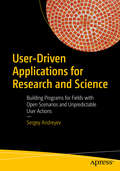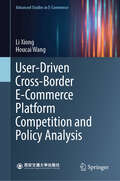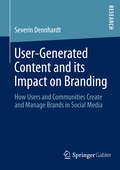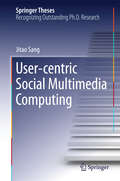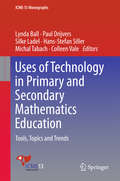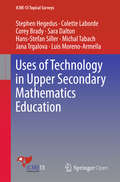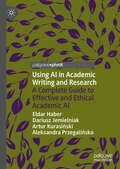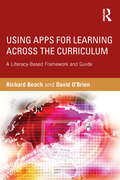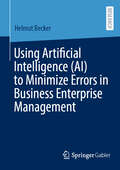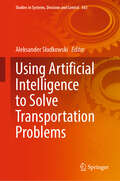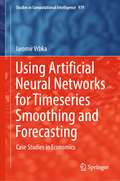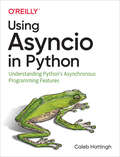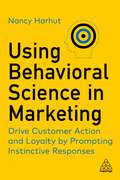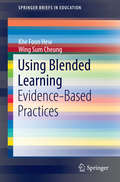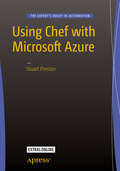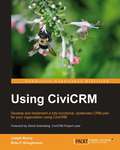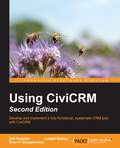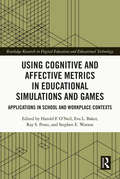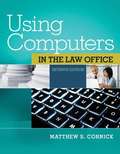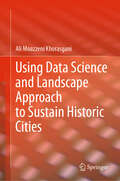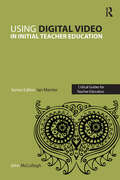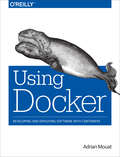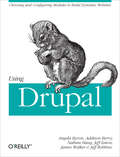- Table View
- List View
User-Driven Applications for Research and Science: Building Programs for Fields with Open Scenarios and Unpredictable User Actions
by Sergey AndreyevBuild programs that give users full control of their applications in order to meet end users' unique needs and scenarios. Over the last couple of decades, there has been an ongoing quandary in the developer world. Developers are enlisted to build applications to meet users’ demands; users get applications that meet the criteria from the developers’ point of view, but they are far from what the users envisioned. The difference is often wide and nearly catastrophic in fields where users’ actions are nearly impossible to predict, such as science, research work, financial analysis, and others. End users get frustrated with the applications because they were not built with their use cases in mind. For a long time, it was assumed that the developers who created the code should drive their programs and be responsible for all scenarios. While generally not an issue in simple programs, this view is wrong for complex applications in the field of science. These end users are the best specialists in their respective fields and need applications to work beyond the scenarios prepared and allowed for by developers.This book teaches you methods to manage your applications in a way that gives control to your target end users. You will learn proven methods using an easy and predictable instrument, the all-powerful algorithm, to create objects that are movable and re-sizable by users.Get ready to learn by example, using an algorithm of total movability and experience, implemented in different situations. You will begin with the simplest code examples and work your way up to real, complicated programs applicable in STEM fields.What You Will Learn Pass the control of your programs from developers to end usersUnderstand that the most valuable result is not the algorithm itself, but the consequence of using itBuild user-driven applications that include total movability of screen elementsSee concepts applied in real situations and scenariosBe exposed to well-known programs and tasks for developing user-driven applicationsAccess accompanying code written in C# and available on GitHub Who This Book Is ForDevelopers who want to write or design programs that give their target end users full control over their application
User-Driven Cross-Border E-Commerce Platform Competition and Policy Analysis (Advanced Studies in E-Commerce)
by Li Xiong Houcai WangThis book constructs a four-dimensional driving model for customer perception of cross-border e-commerce retail imports from a consumer perspective, and constructs a secondary indicator of the four-dimensional driving model for customer perception of cross-border e-commerce retail imports based on product and service theme attributes. It studies the competitive advantages of importing cross-border e-commerce from the perspectives of platform enterprises and users. At the same time, by constructing a research model for evaluating cross-border e-commerce policies, the book analyzes the internal logic and evolution laws of China's cross-border e-commerce policy texts, evaluates the effectiveness of the implementation of policies in the comprehensive experimental zone for cross-border e-commerce, and studies the impact mechanism of environmental factors on policy implementation. This will help readers further understand the implementation of cross-border e-commerce policies and comparethe differences in policy implementation among different comprehensive experimental zones. Improving the accuracy of policy formulation and optimizing and improving the cross-border e-commerce policy system have important theoretical significance and practical value in promoting China's foreign economic development.The translation was done with the help of artificial intelligence. A subsequent human revision was done primarily in terms of content.
User-Generated Content and its Impact on Branding
by Severin DennhardtThe emergence of social media as one of the driving forces of consumers' online experiences today also challenges our current understanding on marketing and brand management. The effects of brands' social media involvement are to this day uncertain. Severin Dennhardt shows that social media and user-generated brands do have a strong influence on brands. Four independent studies demonstrate that first, successful brands can be created in virtual worlds, second, user-generated content drives the creation of unique brands, third social media strongly influences the social value perception of brands, and fourth, social media impacts consumers' purchase decision process.
User-centric Social Multimedia Computing
by Jitao SangThis book presents the first paradigm of social multimedia computing completely from the user perspective. Different from traditional multimedia and web multimedia computing which are content-centric, social multimedia computing rises under the participatory Web2. 0 and is essentially user-centric. The goal of this book is to emphasize the user factor in facilitating effective solutions towards both multimedia content analysis, user modeling and customized user services. Advanced topics like cross-network social multimedia computing are also introduced as extensions and potential directions along this research line.
Uses of Technology in Primary and Secondary Mathematics Education: Tools, Topics And Trends (ICME-13 Monographs)
by Paul Drijvers Lynda Ball Hans-Stefan Siller Silke Ladel Michal Tabach Colleen ValeThis book provides international perspectives on the use of digital technologies in primary, lower secondary and upper secondary school mathematics. It gathers contributions by the members of three topic study groups from the 13th International Congress on Mathematical Education and covers a range of themes that will appeal to researchers and practitioners alike. The chapters include studies on technologies such as virtual manipulatives, apps, custom-built assessment tools, dynamic geometry, computer algebra systems and communication tools. Chiefly focusing on teaching and learning mathematics, the book also includes two chapters that address the evidence for technologies’ effects on school mathematics. The diverse technologies considered provide a broad overview of the potential that digital solutions hold in connection with teaching and learning. The chapters provide both a snapshot of the status quo of technologies in school mathematics, and outline how they might impact school mathematics ten to twenty years from now.
Uses of Technology in Upper Secondary Mathematics Education
by Hans-Stefan Siller Stephen Hegedus Colette Laborde Corey Brady Sara Dalton Michal Tabach Jana Trgalova Luis Moreno-ArmellaThis survey addresses the use of technology in upper secondary mathematics education from four points of view: theoretical analysis of epistemological and cognitive aspects of activity in new technology mediated learning environments, the changes brought by technology in the interactions between environment, students and teachers, the interrelations between mathematical activities and technology, skills and competencies that must be developed in teacher education. Research shows that the use of some technologies may deeply change the solving processes and contribute to impact the learning processes. The questions are which technologies to choose for which purposes, and how to integrate them, so as to maximize all students' agency. In particular the role of the teacher in classrooms and the content of teacher education programs are critical for taking full advantage of technology in teaching practice.
Using AI in Academic Writing and Research: A Complete Guide to Effective and Ethical Academic AI
by Dariusz Jemielniak Eldar Haber Aleksandra Przegalińska Artur KurasińskiThis book comprehensively explores how AI tools can revolutionize academic writing, research, grant proposals, and educational practices. With a focus on practical applications, ethical considerations, and future trends, the book serves as an indispensable roadmap for academics, researchers, and educators eager to integrate AI into their work. Whether you're looking to enhance your research capabilities, craft compelling grant proposals, personalize learning experiences, or lead your institution into the future, this book provides the insights and tools necessary to navigate and shape the AI-enhanced landscape of academia. It demonstrates how to redefine scholarly work with cutting-edge AI innovations through real-life, practical examples, yet keeping the level of generalization high enough to keep it relevant for a few years. By balancing specific, actionable insights with broader perspectives, this book equips readers to not only adapt to but actively influence the evolving role of AI in higher education, research, and funding acquisition, ensuring its value as a resource both now and in the coming years.
Using Apps for Learning Across the Curriculum: A Literacy-Based Framework and Guide
by David O'Brien Richard BeachHow can apps be used to foster learning with literacy across the curriculum? This book offers both a theoretical framework for considering app affordances and practical ways to use apps to build students’ disciplinary literacies and to foster a wide range of literacy practices. Using Apps for Learning Across the Curriculum presents a wide range of different apps and also assesses their value features methods for and apps related to planning instruction and assessing student learning identifies favorite apps whose affordances are most likely to foster certain disciplinary literacies includes resources and apps for professional development provides examples of student learning in the classroom A website (www.usingipads.pbworks.com) with resources for teaching and further reading for each chapter, a link to a blog for continuing conversations about topics in the book (appsforlearningliteracies.com), and more enhance the usefulness of the book.
Using Artificial Intelligence (AI) to Minimize Errors in Business Enterprise Management
by Helmut BeckerThis book explores how artificial intelligence (AI) can revolutionize error culture and error management to enhance business efficiency and resilience. Anchored in established frameworks like ISO 31000 and COSO ERM, it demonstrates how principles from High Reliability Organizations (HROs) can be adapted to diverse industries. Through comprehensive research, including a unique 56-criteria checklist, it offers actionable strategies for identifying and mitigating risk management weaknesses. By leveraging AI's predictive and real-time capabilities, the book empowers leaders to adopt proactive approaches to organizational safety and sustainability while addressing ethical considerations and practical challenges.
Using Artificial Intelligence to Solve Transportation Problems (Studies in Systems, Decision and Control #563)
by Aleksander SładkowskiThis book focuses on the role of Artificial Intelligence in solving transportation problems and presents papers from around the world on AI in transportation. Currently, the development of computer technology and software has led to what can be said to be the beginning of a fundamentally new stage in science and technology. This new level is called “Artificial Intelligence (AI).” AI can be used in any area of human activity. One of the broadest uses of AI comes from transportation, broadly understood. Obviously, it is impossible to present all the possibilities of AI in the field of design, production and operation of transport in one book. But the authors of this monothematic monograph tried to describe achievements in their areas. In particular, the use of AI allows you to save energy and fuel when using vehicles, improve the preparation and implementation of transport processes, simplify warehouse operations, analyze and modernize existing transport infrastructure. These and other aspects of the use of AI in the transport industry are discussed in the monograph by specialists from Greece, China, Poland and other countries. This book can be recommended for study by scientists and professionals. It can also be selected by teachers as additional material when preparing relevant courses. Moreover, it can also be recommended for any readers seriously interested in the transportation industry.
Using Artificial Neural Networks for Timeseries Smoothing and Forecasting: Case Studies in Economics (Studies in Computational Intelligence #979)
by Jaromír VrbkaThe aim of this publication is to identify and apply suitable methods for analysing and predicting the time series of gold prices, together with acquainting the reader with the history and characteristics of the methods and with the time series issues in general. Both statistical and econometric methods, and especially artificial intelligence methods, are used in the case studies. The publication presents both traditional and innovative methods on the theoretical level, always accompanied by a case study, i.e. their specific use in practice. Furthermore, a comprehensive comparative analysis of the individual methods is provided. The book is intended for readers from the ranks of academic staff, students of universities of economics, but also the scientists and practitioners dealing with the time series prediction. From the point of view of practical application, it could provide useful information for speculators and traders on financial markets, especially the commodity markets.
Using Asyncio in Python: Understanding Python's Asynchronous Programming Features
by Caleb HattinghIf you’re among the Python developers put off by asyncio’s complexity, it’s time to take another look. Asyncio is complicated because it aims to solve problems in concurrent network programming for both framework and end-user developers. The features you need to consider are a small subset of the whole asyncio API, but picking out the right features is the tricky part. That’s where this practical book comes in.Veteran Python developer Caleb Hattingh helps you gain a basic understanding of asyncio’s building blocks—enough to get started writing simple event-based programs. You’ll learn why asyncio offers a safer alternative to preemptive multitasking (threading) and how this API provides a simpleway to support thousands of simultaneous socket connections.Get a critical comparison of asyncio and threading for concurrent network programmingTake an asyncio walk-through, including a quickstart guidefor hitting the ground looping with event-based programmingLearn the difference between asyncio features for end-user developers and those for framework developersUnderstand asyncio’s new async/await language syntax, including coroutines and task and future APIsGet detailed case studies (with code) of some popular asyncio-compatible third-party libraries
Using Behavioral Science in Marketing: Drive Customer Action and Loyalty by Prompting Instinctive Responses
by Nancy HarhutIncrease engagement, response rates and the ROI of marketing initiatives with this step-by-step guide to harnessing hardwired consumer behavior and instinctive responses. Using Behavioral Science in Marketing shows how to apply behavioral science principles in key areas of marketing, including marketing communications, email, direct mail and ad campaigns, social media marketing and sales funnel conversion strategies. Highly practical and accessible, it includes case studies and examples from AT&T, Apple, Spotify and The Wall Street Journal showing how these approaches have been used in practice. Using Behavioral Science in Marketing also reveals how to increase consumer involvement and engagement, convey exclusivity and desirability, and prompt customer action and loyalty with scientifically proven principles such as autonomy bias, storytelling, and the Von Restorff effect. Featuring common mistakes to avoid and key takeaways at the end of each chapter, it's also accompanied by downloadable checklists and an interactive template to use in practice. In a highly competitive space, where even an incremental advantage can result in significant uplifts, this is a crucial resource to create stand out and successful marketing-especially for marketers in highly regulated or highly competitive environments.
Using Blended Learning
by Khe Foon Hew Wing Sum CheungThis book discusses evidence-based practices related to the use of blended learning in both K-12 and higher education settings. Specifically, this book features evidence-based practices in relation to the following five learning goals: (a) Fostering students' attitude change toward country, (b) Helping students' solve ill-structured design task problems, (c) Improving students' critical thinking in assessing sources of information, (d) Improving students' narrative and argumentative writing abilities and (e) Enhancing students' knowledge retention and understanding. To achieve this aim, the authors draw upon their own research studies as well as some other relevant studies to reveal the pedagogical approaches, the specific instructional/learning activities, the technologies utilized and the overall framework for developing blended learning experiences.
Using Chef with Microsoft Azure
by Stuart PrestonThis book is your hands-on guide to infrastructure provisioning and configuration management in the cloud using Chef's open source, cross-platform toolset. With over 10,000 customers joining the Microsoft Azure cloud platform each week and steadily increasing usage, the need for automation approaches has never been greater. This book provides both practical examples and a much needed strategic overview of how these two technologies can be combined. Using Chef with Microsoft Azure takes you through the process of writing 'recipes' in Chef to describe your infrastructure as code, and simplify your configuration management processes. You'll also meet the Chef tools that can be used to provision complete environments within Microsoft Azure. There are now a wide variety of tools and approaches that can be taken to provision resources such as virtual machines within Microsoft Azure. This book demonstrates them, discusses the benefits and weaknesses of each approach, and shows how a continuous provisioning pipeline can be established as part of a reliable, repeatable, and robust provisioning process. Each chapter has practical exercises that highlight the capabilities of both Chef and Microsoft Azure from an automation perspective and can be executed on Windows, Mac, or Linux platforms. In this book, you'll learn: The purpose and principles behind automated provisioning Microsoft Azure concepts and management options How to deploy Chef Azure Virtual Machine Extensions using PowerShell, Azure command-line tools, and Chef Provisioning Chef Provisioning techniques, including provisioning PaaS resources such as KeyVault How to integrate quality tooling into the Chef development lifecycle, including Test Kitchen and InSpec with Azure compute resources How to set up a pipeline for continuous provisioning with Chef and Azure What you'll learn The purpose and principles behind automated provisioning, and why Chef could be the right tool for you Microsoft Azure concepts and management options How to install a Chef 12 server from the Azure Marketplace How to provision machines, using both Knife Azure and Chef Provisioning, including examples using Ubuntu and Windows How to deploy Chef Azure Virtual Machine Extensions using PowerShell, Knife Azure, and Chef Provisioning Advanced Chef Provisioning techniques, including provisioning many machines in batch mode, provisioning PaaS resources, and provisioning a multi-tier application How to integrate quality tooling into the Chef development lifecycle, including ChefSpec, Test Kitchen, and more Considerations when using Chef in a real-world environment How to set up a pipeline for continuous provisioning with Chef and Azure Who this book is for This book is for infrastructure platform and operations engineers and DevOps specialists/practitioners working with infrastructure and platform provisioning on Microsoft's public cloud, Azure. An understanding of programming in any language would be beneficial, but not necessary as the examples are designed to be easily readable by anyone with general IT experience. While it is expected most users picking up this book will be on the Windows platform, a good proportion of compute workload on the Azure platform is Linux based. As a result the book includes examples that are relevant to both Windows and Linux platforms.
Using CiviCRM
by Brian Shaughnessy Joseph MurrayThis book is a step-by-step tutorial with practical examples, introduced by a planning framework and illustrations of good relationship management techniques for a variety of situations. We begin with basics such as installation, low-level implementation, and CiviCRM's core modules before covering CiviCRM's advanced features and issues such as customization of CiviCRM and integrating it with Joomla! and Drupal. You should be able to quickly grasp and implement the basic elements of CiviCRM before moving on to the more advanced features and tools. This book is for project implementers, organization leaders, staff, and volunteers in advocacy, non-profit, and non-governmental organizations, elected officials, professional/trade associations, political campaigns and parties, government agencies, and other similar organizations who want to implement CiviCRM in a manner tailored to their organization's size, culture, and needs. It addresses CRM strategists, implementers, administrators, and end users looking to become power users in communicating, fundraising, managing events, memberships, grants, cases, and people-resource management.
Using CiviCRM - Second Edition
by Joseph Murray Brian P. Shaughnessy Erik HommelDevelop and implement a fully-functional, systematic CRM plan with CiviCRM About This Book * Develop an integrated online system that manages contacts, donations, event registrations, memberships, bulk e-mail, campaigns, case management, and other functions such as activity tracking, grant distribution, and reporting. * Plan a constituency relationship management strategy with ladders of engagement that will improve how your organization realizes its mission. * Use case studies and step-by-step examples to put the raw concepts into real-life terminology and build your solutions. Who This Book Is For The book is primarily for administrators tasked with implementing, configuring, maintaining, and updating CiviCRM, and staff users who are looking to better understand the tools available in order to become power users. CiviCRM is software that may be used by advocacy groups, non-profit, and non-governmental organizations, elected officials, professional and trade associations, government entities, political campaigns and parties, and other similar organizations, and this book will prove useful to all such users. What You Will Learn * Install and configure your CiviCRM * Analyze your current workflows and processes to translate them effectively into the CiviCRM model * Build an integrated system to solicit, retain, and manage your donors and members through robust management and reporting tools for administrators * Raise more money with CiviCRM with effective solicitation campaigns * Market events effectively and track registrations and payments * Improve communications with constituents using targeted broadcast e-mail campaigns * Track ongoing communications with constituents including from Outlook and Gmail using activities and case management tools * Take advantage of the many CiviCRM tools to generate both simple and complex event structures and manage registrants through every phase of the project In Detail CiviCRM provides a powerful toolbox of resources to help organizations manage relationships with constituents. It is free, open source, web-based, and geared specifically to meet the constituent relationship management needs of the not-for-profit sector. Beginning with broader questions about how your organization is structured, which existing workflows are critical to your operations, and the overarching purpose of a centralized CRM, the book proceeds step by step through configuring CiviCRM, understanding the choices when setting up the system, importing data, and exploring the breadth of tools available throughout the system. You will see how to best use this software to handle event registrations, accept and track contributions, manage paid and free memberships and subscriptions, segment contacts, send bulk e-mails with open and click-through tracking, manage outreach campaigns, and set up case management workflows that match your organization's roles and rules. With specific emphasis on helping implementers ask the right questions, consider key principals when setting up the system, and understand usage through case studies and examples, the book comprehensively reviews the functionality of CiviCRM and the opportunities it provides. With this book, you can help your organization better achieve its mission as a charity, industry association, professional society, political advocacy group, community group, government agency, or other similar organization and position yourself to become a power user who efficiently and effectively navigates the system. Style and approach This guide is packed with step-by-step tutorials and real-life examples interspersed with practical advice and best practices on how to use CiviCRM strategically. You will be able to quickly grasp and implement the basic elements of CiviCRM before moving on to more advanced tools.
Using Cognitive and Affective Metrics in Educational Simulations and Games: Applications in School and Workplace Contexts (Routledge Research in Digital Education and Educational Technology)
by Harold F. O'NeilPresenting original studies and rich conceptual analyses, this volume explores how cognitive and affective metrics can be used to effectively assess, modify, and enhance learning and assessment outcomes of simulations and games used in education and training.The volume responds to the increasing use of computer-based simulations and games across academic and professional sectors by bringing together contributions from different research communities, including K-12 and postsecondary education, medical, and military contexts. Drawing on empirical results, the chapter authors focus on the design and assessment of educational simulations and games. They describe how quantitative and qualitative metrics can be used effectively to evaluate and tailor instructional resources to the cognitive and affective needs of the individual learner. In doing so, the volume enhances understanding of how games and simulations can intersect with the science of learning to improve educational outcomes. Given its rigorous and multidisciplinary approach, this book will prove an indispensable resource for researchers and scholars in the fields of educational assessment and evaluation, educational technology, military psychology, and educational psychology.
Using Communications Media in Open and Flexible Learning (Open and Flexible Learning Series)
by Mason, RobinAn introduction to three types of interactive media - computer conferencing, audiographics and video conferencing - which explains how each type can be used in the open learning environment. It describes attributes and limitations, analyzing appropriate applications through case studies.
Using Computers in the Law Office (Seventh Edition)
by Matthew S. CornickUsing Computers in the Law Office, Seventh Edition, is designed to give students both theoretical understanding and practical experience with common law-office computer applications. These include both widely used applications, such as Microsoft Word, Excel, PowerPoint, and HotDocs; and programs specific to the law office, such as Tabs3, AbacusLaw, Clio, Discover FY, CaseMap, TimeMap, Westlaw, Lex-isNexis, and TrialDirector.
Using Data Science and Landscape Approach to Sustain Historic Cities
by Ali Moazzeni KhorasganiThis book comprehensively explores sustaining historic cities using a landscape approach and data science. The author offers valuable insights for professionals and enthusiasts interested in preserving and developing urban heritage through a data driven approach. Drawing on the synergy between landscape architecture and data science, the book delves into the intricate interplay between historical, cultural, and environmental factors in urban settings. Readers will understand how to navigate historic cities' complex challenges through case studies, research findings, and practical methodologies. The book equips readers with innovative strategies for preserving the authenticity of these cities while embracing sustainable development practices. By blending theory and real-world applications, this book is a comprehensive guide for creating thriving, resilient, and culturally rich urban environments.
Using Digital Video in Initial Teacher Education (Critical Guides for Teacher Educators)
by John McCullaghA research-based, critical yet practical exploration of the benefits of using digital video in teacher education.Digital video is easy to use and student teachers find it incredibly helpful. Since Dwight Allen first used microteaching five decades ago, video has been recognised as an ideal medium for capturing the complex nature of teaching. Through its accurate and honest representation of reality it reveals both the cognitive and affective aspects of learning to teach.This book serves as a theory-related rationale and a practice-informed critical guide for teacher educators considering how best to use video within their programmes. It explores how video technology can be used to enrich learning in both higher education and school settings, enhancing the continuity of the learning experience. Using evidence-based examples of best practice and critical discussions relating theory and policy to practice, it encourages teacher educators to engage with the use of video technology and explore how it meets the needs of learners and the current requirements of initial teacher education.
Using Docker: Developing and Deploying Software with Containers
by Adrian MouatDocker containers offer simpler, faster, and more robust methods for developing, distributing, and running software than previously available. With this hands-on guide, you’ll learn why containers are so important, what you’ll gain by adopting Docker, and how to make it part of your development process.Ideal for developers, operations engineers, and system administrators—especially those keen to embrace a DevOps approach—Using Docker will take you from Docker and container basics to running dozens of containers on a multi-host system with networking and scheduling. The core of the book walks you through the steps needed to develop, test, and deploy a web application with Docker.Get started with Docker by building and deploying a simple web applicationUse Continuous Deployment techniques to push your application to production multiple times a dayLearn various options and techniques for logging and monitoring multiple containersExamine networking and service discovery: how do containers find each other and how do you connect them?Orchestrate and cluster containers to address load-balancing, scaling, failover, and schedulingSecure your system by following the principles of defense-in-depth and least privilege
Using Drupal
by Nathan Haug Jeff Robbins Angela Byron Jeff Eaton James Walker Addison BerryWith the recipes in this book, you can take full advantage of the vast collection of community-contributed modules that make the Drupal web framework useful and unique. You'll get the information you need about how to combine modules in interesting ways (with a minimum of code-wrangling) to develop a variety of community-driven websites. Each chapter describes a case study and outlines specific requirements for one of several projects included in the book -- a wiki, publishing workflow site, photo gallery, product review site, online store, user group site, and more. With Using Drupal, you will: Get an overview of Drupal concepts and key modules introduced in each chapter, with a bird's-eye view of each module's specialty and how it works Explore various solutions within Drupal that meet the requirements for the project, with details about which modules are selected and why Learn how to configure modules, with step-by-step recipes for building the precise functionality the project requires Get information on additional modules that will make the project even more powerful Be able to access the modules used in the chapter, along with other resources Newcomers will find a thorough introduction to the framework, while experienced Drupal developers will learn best practices for building powerful websites. With Using Drupal, you'll find concrete and creative solutions for developing the exact community website you have in mind.
Using Drupal
by Nathan Haug Jeff Robbins Angela Byron Jeff Eaton James Walker Addison BerryWith the recipes in this book, you can take full advantage of the vast collection of community-contributed modules that make the Drupal web framework useful and unique. You'll get the information you need about how to combine modules in interesting ways (with a minimum of code-wrangling) to develop a variety of community-driven websites. Each chapter describes a case study and outlines specific requirements for one of several projects included in the book -- a wiki, publishing workflow site, photo gallery, product review site, online store, user group site, and more. With Using Drupal, you will:Get an overview of Drupal concepts and key modules introduced in each chapter, with a bird's-eye view of each module's specialty and how it worksExplore various solutions within Drupal that meet the requirements for the project, with details about which modules are selected and whyLearn how to configure modules, with step-by-step recipes for building the precise functionality the project requiresGet information on additional modules that will make the project even more powerfulBe able to access the modules used in the chapter, along with other resourcesNewcomers will find a thorough introduction to the framework, while experienced Drupal developers will learn best practices for building powerful websites. With Using Drupal, you'll find concrete and creative solutions for developing the exact community website you have in mind.
